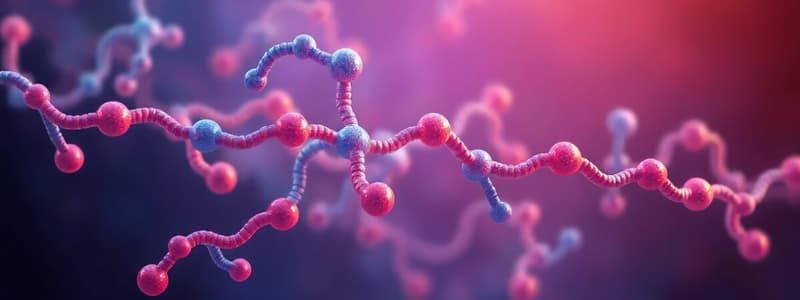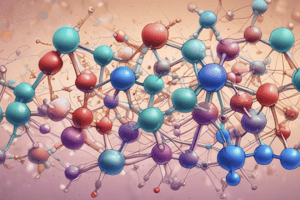Podcast
Questions and Answers
What is the net charge on glutamate at pH = 7?
What is the net charge on glutamate at pH = 7?
-1
What would be the net charge of glutamate be at pH = 2?
What would be the net charge of glutamate be at pH = 2?
+1
What is the net charge of tyrosine at pH = 7?
What is the net charge of tyrosine at pH = 7?
0
What would the net charge of tyrosine be at pH = 2?
What would the net charge of tyrosine be at pH = 2?
Flashcards
What is Biochemistry?
What is Biochemistry?
The study of the physical and chemical principles that govern living organisms, including the structure, function, and interactions of biological molecules.
What are Enzymes?
What are Enzymes?
Enzymes are biological catalysts that speed up chemical reactions in living organisms by lowering the activation energy required for the reaction to occur.
What are Proteins?
What are Proteins?
Proteins are complex macromolecules composed of one or more long chains of amino acids linked together by peptide bonds.
What are Amino Acids?
What are Amino Acids?
Signup and view all the flashcards
What is a Protein's Primary Structure?
What is a Protein's Primary Structure?
Signup and view all the flashcards
What is a Protein's Secondary Structure?
What is a Protein's Secondary Structure?
Signup and view all the flashcards
What is a Protein's Tertiary Structure?
What is a Protein's Tertiary Structure?
Signup and view all the flashcards
What is a Protein's Quaternary Structure?
What is a Protein's Quaternary Structure?
Signup and view all the flashcards
What is Protein Folding?
What is Protein Folding?
Signup and view all the flashcards
What is a Peptide?
What is a Peptide?
Signup and view all the flashcards
What is a Peptide Bond?
What is a Peptide Bond?
Signup and view all the flashcards
What is the N-terminus of a Protein?
What is the N-terminus of a Protein?
Signup and view all the flashcards
What is the C-terminus of a Protein?
What is the C-terminus of a Protein?
Signup and view all the flashcards
What is Thermodynamics?
What is Thermodynamics?
Signup and view all the flashcards
What is Energy?
What is Energy?
Signup and view all the flashcards
What is Enthalpy (H)?
What is Enthalpy (H)?
Signup and view all the flashcards
What is Entropy (S)?
What is Entropy (S)?
Signup and view all the flashcards
What is Gibbs Free Energy (G)?
What is Gibbs Free Energy (G)?
Signup and view all the flashcards
What is an Exergonic Reaction?
What is an Exergonic Reaction?
Signup and view all the flashcards
What is an Endergonic Reaction?
What is an Endergonic Reaction?
Signup and view all the flashcards
What is the Hydrophobic Effect?
What is the Hydrophobic Effect?
Signup and view all the flashcards
What is Delta H (ΔH)?
What is Delta H (ΔH)?
Signup and view all the flashcards
What is Delta S (ΔS)?
What is Delta S (ΔS)?
Signup and view all the flashcards
What is the Isoelectric Point?
What is the Isoelectric Point?
Signup and view all the flashcards
What is Dehydration Synthesis?
What is Dehydration Synthesis?
Signup and view all the flashcards
What is Hydrolysis?
What is Hydrolysis?
Signup and view all the flashcards
What is a Polymer?
What is a Polymer?
Signup and view all the flashcards
What is a Monomer?
What is a Monomer?
Signup and view all the flashcards
What is a Hydrogen Bond?
What is a Hydrogen Bond?
Signup and view all the flashcards
What is Pi-stacking?
What is Pi-stacking?
Signup and view all the flashcards
What is the London Dispersion Force?
What is the London Dispersion Force?
Signup and view all the flashcards
Study Notes
Amino Acids and Peptides (CHM 6620/7620)
- This is a lecture on amino acids and peptides.
- The lecture is for CHM 6620/7620.
- The lecture was on 8/29/2024.
- The lecture material is Berg Chapter 2.
Quick Announcements
- Supplemental syllabus is available on Canvas for honor's option students.
- Supplemental syllabus for grad students is on Canvas.
- Problem Set 1 is due on Tuesday, September 3rd at noon.
- The course schedule on the syllabus is posted.
- No classes will meet on Election Day, Tuesday, November 5th.
Threshold Concepts of Biochemistry
- Key concepts of biochemistry are discussed.
- Physical basis for interactions is one concept shown.
- Thermodynamics of macromolecular structure formation is another concept.
- Free energy is a third concept shown.
- Steady state is a topic.
Proteins
- Proteins are the key agents in biological functions.
- Proteins function in catalysis (e.g. enolase, DNA polymerase).
- Proteins function in transport (e.g. hemoglobin, lactose permease).
- Proteins function in structure (e.g. collagen, keratin).
- Proteins function in motion (e.g. myosin, actin).
Amino Acids: Building Blocks of Protein
- Proteins are linear heteropolymers of α-amino acids.
- Amino acids have properties well-suited to diverse biological functions including: capacity to polymerize, useful acid-base properties, varied physical properties, and varied chemical functionalities.
- Amino acids differ in the R substituent.
Amino Acids: Atom Naming
- Organic nomenclature uses numbers starting from one end.
- Biochemical designation starts from the α-carbon and proceeds through the R-group using Greek letters.
All Amino Acids
- All amino acids are chiral except glycine.
- Proteins only contain L-amino acids.
Protonation States of Amino Acids
- There is a graph showing the relationship between pH and the protonation states of amino acids.
- Amino acids have different pK values at different pH levels.
Memorize These Structures and pKa Ballparks
- The slides have a structure list of amino acids that can be charged, positively or negatively charged, and neutral/polar groups.
- pK values for these amino acids are included.
Amino Acid pKa Values
- Acidic and basic properties of amino acids are also presented in this lecture with their typical pK values.
Questions for Students
- There are a number of questions regarding the net charge on glutamate and tyrosine at different pH levels. Details on these specifics are covered on this slide.
Titration of Glutamate
- A graph relating pH and glutamate concentration.
Isoelectric Point
- The isoelectric point (pI) is the pH of an amino acid/peptide that exhibits zero charge.
- Determined by averaging the pK values involving the charge neutral species.
Formation of Peptides
- Peptides are condensation products of amino acids.
- Peptides are smaller than proteins (lower molecular weight than 10 kDa)
Peptide Drawing
- Peptides are drawn from the N to C termini.
- Using full amino acid names or 3-letter or one-letter abbreviation codes is discussed.
Let's Draw a Peptide
- This slide gives a recipe/process for drawing peptides.
Physical Basis for Interactions
- The physical basis for interactions is described in terms of covalent, non-covalent-intermolecular forces.
- Specific types of non-covalent intermolecular forces include hydrogen bonds and pi-stacking between the base pairs, also important for DNA, along with the energies of base pairing and base stacking.
- Factors that have to be considered for aqueous media are also discussed in this section.
Free Energy
- Free energy discussions are covered (Gibbs Free Energy) and the calculation equations shown to show the relationship between free energy and enthalpy and entropy.
- In the context of macromolecular assemblies, electrostatic interactions and the hydrophobic effect are discussed.
Studying That Suits You
Use AI to generate personalized quizzes and flashcards to suit your learning preferences.




